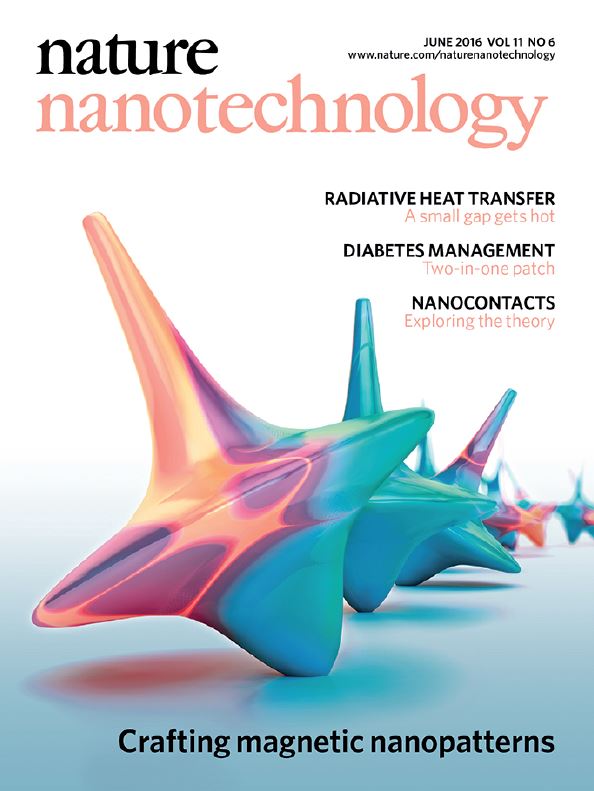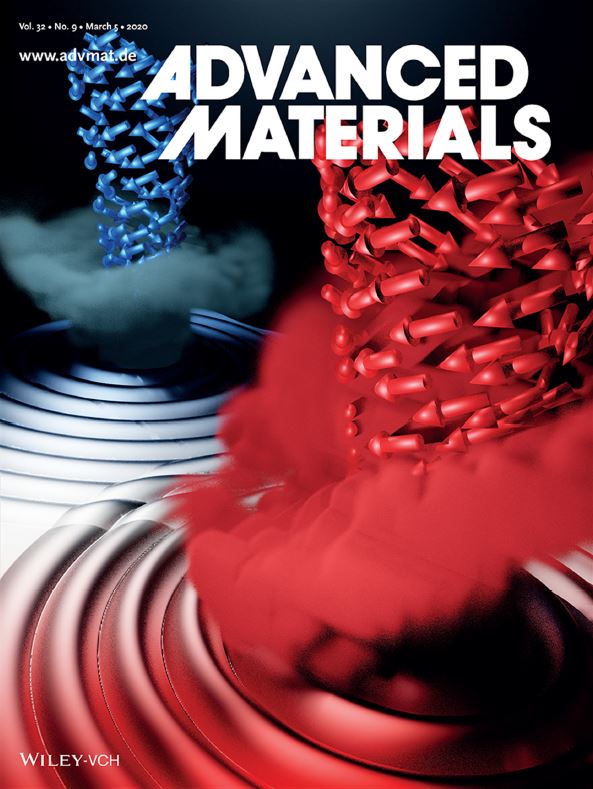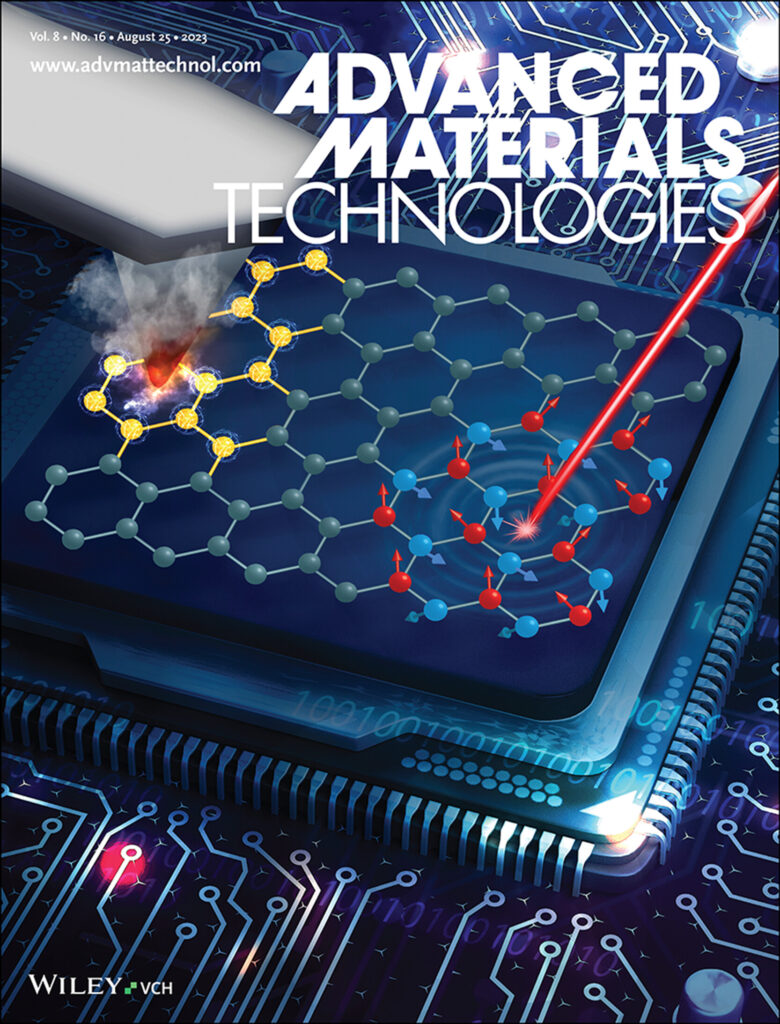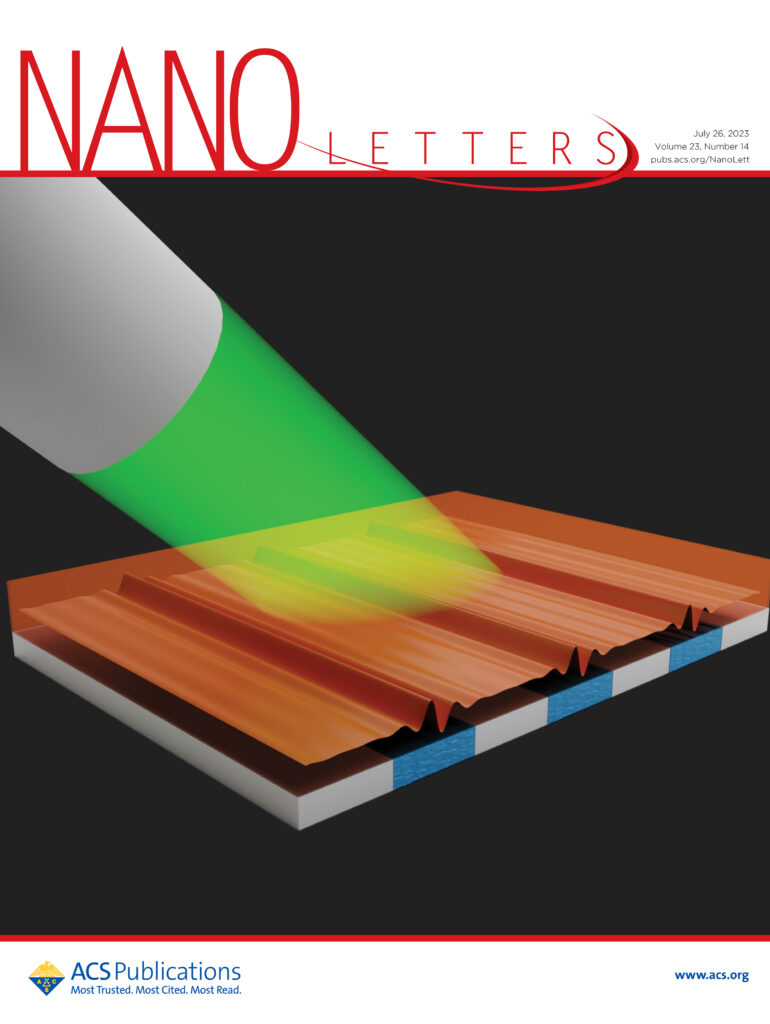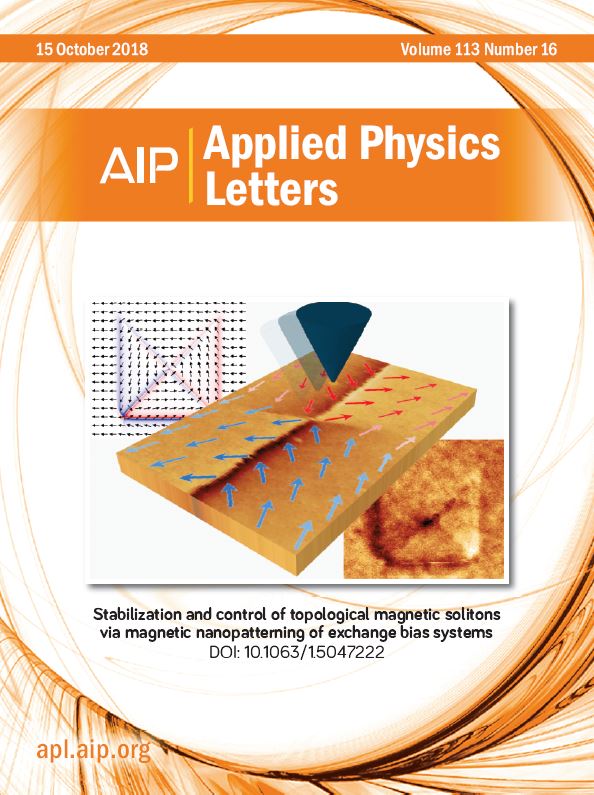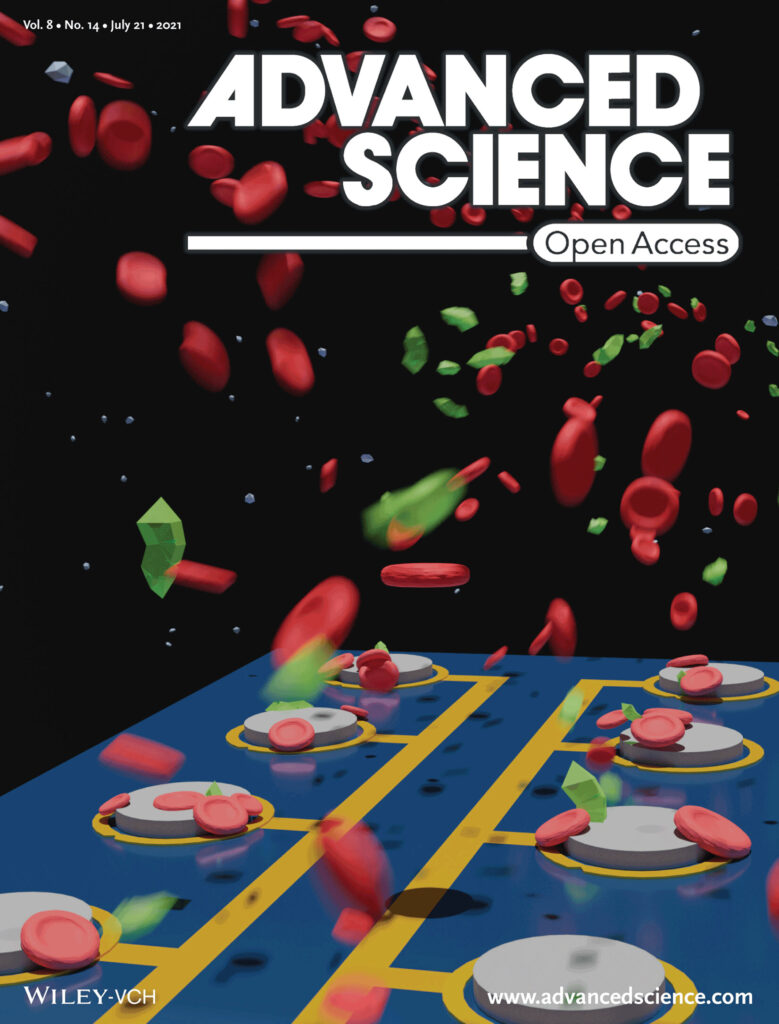Here you find a list of highlighted publications, and the full list of our publications on scientific journals, book contributions, patents and the cover page gallery. Browse papers by year 2023, 2022, 2021, 2020, 2019, 2018, 2017, 2016.
Publications Highlights
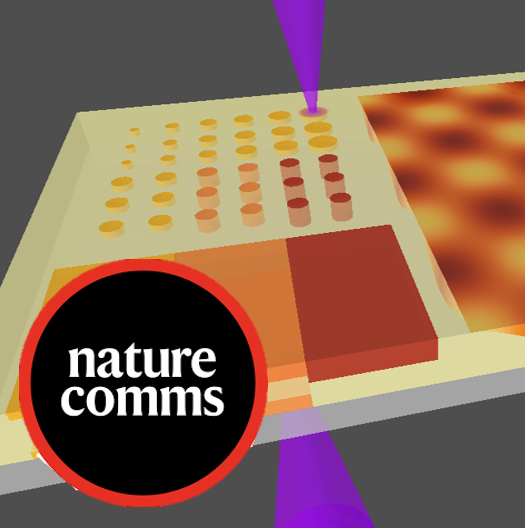
Three-dimensional nanoscale control of magnetism in crystalline Yttrium Iron Garnet
V. Levati, M. Vitali et al. Nature Communications (2025).
We demonstrate a non-destructive method for writing three-dimensional magnetic patterns in crystalline Yttrium Iron Garnet (YIG) films using focused UV laser irradiation to locally enhance perpendicular magnetic anisotropy. This technique enables the precise fabrication of 3D magnonic crystals with tunable spin-wave properties, paving the way for advanced architectures in magnonic and magneto-optic devices.
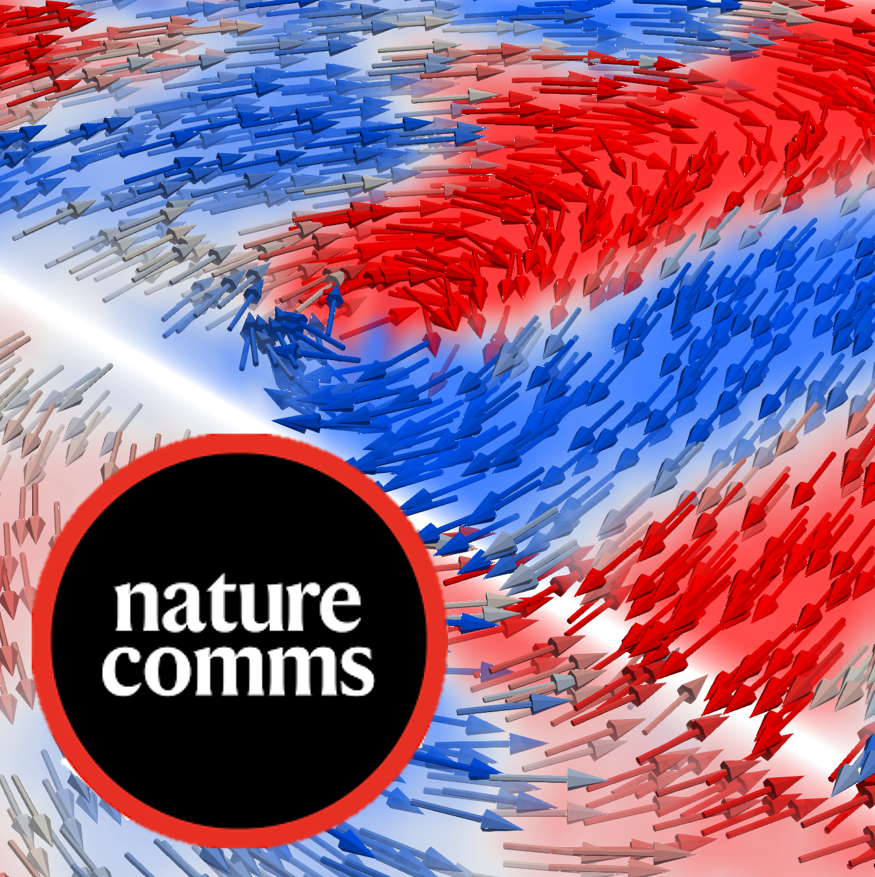
Three-dimensional spin-wave dynamics, localization and interference in a synthetic antiferromagnet
D. Girardi et al. Nature Communications (2024).
We use X-Ray Microscopy Imaging for acquiring time-resolved snapshots of the spin dynamics in a synthetic antiferromagnet, with nanoscale spatial resolution and sub-nanosecond temporal resolution. This allowed us to retrieve the full three-dimensional structure of the spin-wave modes, revealing previously inaccessible features on their anatomy, propagation and interaction within the volume of the material.

Phase Nanoengineering via Thermal Scanning Probe Lithography and Direct Laser Writing
V. Levati et al. Advanced Materials Technologies (2023).
A perspective on Phase Nanoengineering. Nanomaterials and devices are created using advanced nanofabrication techniques to directly nanostructure condensed matter systems, by inducing highly controlled, localized, and stable changes in the electronic, magnetic, or optical properties.
Experimental Observation of Flat Bands in One-Dimensional Chiral Magnonic Crystals
S. Tacchi et al. Nano Letters (2023).
We study the band diagram of a chiral magnonic crystal consisting of a ferromagnetic film incorporating a periodic Dzyaloshinskii–Moriya coupling via interfacial contact with an array of heavy-metal nanowires. We provide experimental evidence for a strong asymmetry of the spin-wave amplitude and nonreciprocal propagation.

Thermal scanning probe lithography
E. Albisetti et al. Nature Reviews Methods Primers 2, 32 (2022).
We describe the working principles of Thermal scanning probe lithography (tSPL) and highlight the characteristics that make it a powerful tool to locally and directly modify material properties. We cover the applications of tSPL in biomedicine, nanomagnetism and nanoelectronics, and give an outlook on future developments.

Review on magnonics with engineered spin textures
D. Petti et al. Journal of Physics D: Applied Physics, 55, 293003 (2022).
Spin textures, such as non-uniform domain arrangements, domain walls and skyrmions are naturally occurring structures in magnetic materials. In this review, we focus on the recent developments on the control and stabilization of engineered spin textures, and their applications in the field of magnonics.

The 2021 Magnonics Roadmap
A. Barman et al. Journal of Physics: Condensed Matter, 33, 413001 (2021).
Magnonics is a budding research field in nanomagnetism and nanoscience that addresses the use of spin waves (magnons) to transmit, store, and process information. This is a collection of 22 sections written by leading experts in this field who review and discuss the current status besides presenting their vision of future perspectives.

Optically Inspired Nanomagnonics with Nonreciprocal Spin Waves in Synthetic Antiferromagnets
E. Albisetti et al. Advanced Materials, 32, 1906439 (2020).
An optically inspired platform using spin waves is realized, demonstrating the wavefront engineering, focusing, and robust interference of spin waves with nanoscale wavelength. Magnonic nanoantennas based on spin textures are used for launching spatially shaped coherent wavefronts, and generating robust multi-beam interference patterns.

Spatial defects nanoengineering for bipolar conductivity in MoS2
X. Zheng et al. Nature Communications, 11, 1–12 (2020).
We demonstrate the integration of thermochemical scanning probe lithography (tc-SPL) with a flow-through reactive gas cell to achieve nanoscale control of defects in monolayer MoS2. The tc-SPL produced defects can present either p- or n-type doping on demand, allowing the realization of field effect transistors, and p-n junctions

Direct metal contacts on MoS2 with vanishing Schottky barrier via thermal nanolithography
X. Zheng et al. Nature Electronics, 2, 17–25 (2019).
We show that thermal scanning probe lithography can be used to pattern metal electrodes with high reproducibility, sub-10-nm resolution, and high throughput (105 μm2 h−1 per single probe). We pattern metal electrodes in contact with monolayer MoS2 realizing high-quality top-gate and back-gate field-effect transistors.

Nanoscale spin-wave circuits based on engineered reconfigurable spin-textures
E. Albisetti et al. Communications Physics, 1, 56 (2018).
We realize a nanoscale reconfigurable spin-wave circuitry by using patterned spin textures. We directly visualize the channeling and steering of propagating spin waves in arbitrarily shaped nanomagnonic waveguides and we demonstrate a prototypic circuit allowing for the tunable interference of confined spin-waves modes.

Stabilization and control of topological magnetic solitons via magnetic nanopatterning of exchange bias systems
E. Albisetti et al. Applied Physics Letters 113,162401 (2018).
We show the non-volatile creation of vortex-antivortex pairs in an exchange bias bilayer by tailoring vectorially the unidirectional anisotropy at the nanoscale, via thermally assisted magnetic scanning probe lithography. We demonstrate the stabilization of cross and circular Bloch lines within patterned Néel magnetic domain walls.

Nanopatterning reconfigurable magnetic landscapes via thermally assisted scanning probe lithography
E. Albisetti et al. Nature Nanotechnology, 11 (6), 545–551 (2016).
We create reconfigurable magnetic nanopatterns by crafting, at the nanoscale, the magnetic anisotropy landscape of an exchange-biased ferromagnetic film. By scanning the hot tip of a scanning probe microscope, spin textures are directly and reversibly patterned, and used for controlling the excitation and propagation of spin waves.

Thermochemical scanning probe lithography of protein gradients at the nanoscale
E. Albisetti et al. Nanotechnology, 27, 315302 (2016).
We demonstrate the use of thermochemical scanning probe lithography (tc-SPL) for defining micro- and nano-sized patterns with precisely controlled protein concentration. First, tc-SPL is performed by scanning a hot atomic force microscopy tip on a polymeric substrate, then the substrate is functionalized with streptavidin and laminin proteins.
Papers
2023
Experimental Observation of Flat Bands in One-Dimensional Chiral Magnonic Crystals
S. Tacchi, J. Flores-Farías, D. Petti, F. Brevis, A. Cattoni, G. Scaramuzzi, D. Girardi, D. Cortés-Ortuño, R. A. Gallardo, E. Albisetti, G. Carlotti and P. Landeros
Nano Letters (2023)
Featured on the Cover page.
We study the band diagram of a chiral magnonic crystal consisting of a ferromagnetic film incorporating a periodic Dzyaloshinskii–Moriya coupling via interfacial contact with an array of heavy-metal nanowires. We provide experimental evidence for a strong asymmetry of the spin-wave amplitude and nonreciprocal propagation.

Phase Nanoengineering via Thermal Scanning Probe Lithography and Direct Laser Writing
V. Levati, D. Girardi, N. Pellizzi, M. Panzeri, M. Vitali, D. Petti, E. Albisetti
Advanced Materials Technologies (2023)
Featured on the Inside Front Cover page.
A perspective on Phase Nanoengineering. Nanomaterials and devices are created using advanced nanofabrication techniques to directly nanostructure condensed matter systems, by inducing highly controlled, localized, and stable changes in the electronic, magnetic, or optical properties.
Impact of minor hysteresis loops in integrated inductors with ferromagnetic films
S. Cuccurullo, F. Maspero, O. Koplak, G. Pavese, E. Albisetti, M. Cantoni, R. Bertacco
Applied Physics Letters 122, 113503 (2023)
We investigate the impact of minor hysteresis loops in an integrated inductor with spiral geometry sandwiched between two soft magnetic layers made of MoNiFe/Cr multilayers. We find that the inductance is strongly dependent on the AC voltage applied to the device, showing a bell-shaped behavior.
Electrode-dependent asymmetric conduction mechanisms in K0.5Na0.5NbO3 micro-capacitors
C. Groppi, F. Maspero, A. Rovelli, M. Asa, G. Malavena, C. Monzio Compagnoni, E. Albisetti, S. Vangelista, M.A. Badillo-Ávila, R. Bertacco
Materials Science in Semiconductor Processing 160, 107422 (2023)
We investigate the impact of different metallic electrodes with increasing chemical reactivity (Pt, Ni, Ti, Cr), on the asymmetric behavior of the leakage current in M/K0.5Na0.5NbO3/Pt(111) micro-capacitors.
2022

Inertial spin dynamics in epitaxial cobalt films
V. Unikandanunni, R. Medapalli, M. Asa, E. Albisetti, D. Petti, R. Bertacco, E. Fullerton, and S. Bonetti
Physical Review Letters 129, 237201 (2022).
We investigate the spin dynamics driven by terahertz magnetic fields in epitaxial cobalt thin films. We find that the angular momentum relaxation time η is the only material parameter needed to describe all the experimental evidence. Our experiments suggest a proportionality between η and the magnetocrystalline anisotropy.

Thermal scanning probe lithography
E. Albisetti, A. Calò, A. Zanut, X. Zheng, G.M. de Peppo, and E. Riedo
Nature Reviews Methods Primers 2, 32 (2022).
Related Prime View poster Nature Reviews Methods Primers 2, 31 (2022).
We describe the working principles of Thermal scanning probe lithography (tSPL) and highlight the characteristics that make it a powerful tool to locally and directly modify material properties. We cover the applications of tSPL in biomedicine, nanomagnetism and nanoelectronics, and give an outlook on future developments.

Review on magnonics with engineered spin textures
D. Petti, S. Tacchi, and E. Albisetti
Journal of Physics D: Applied Physics, 55, 293003 (2022).
Spin textures, such as non-uniform domain arrangements, domain walls and skyrmions are naturally occurring structures in magnetic materials. In this review, we focus on the recent developments on the control and stabilization of engineered spin textures, and their applications in the field of magnonics.
2021

The 2021 Magnonics Roadmap
A. Barman, G. Gubbiotti, S. Ladak, A. O. Adeyeye, M. Krawczyk, J. Gräfe, C. Adelmann, Sorin Cotofana, A. Naeemi, V. I Vasyuchka, B.Hillebrands, SA Nikitov, H. Yu, D. Grundler, A. Sadovnikov, A.A. Grachev, S.E. Sheshukova, J.-Y. Duquesne, M. Marangolo, G. Csaba, W. Porod, V.E. Demidov, S. Urazhdin, S. Demokritov, E. Albisetti, D. Petti, R. Bertacco, H. Schulteiss et al.
Journal of Physics: Condensed Matter, 33, 413001 (2021).
Magnonics is a budding research field in nanomagnetism and nanoscience that addresses the use of spin waves (magnons) to transmit, store, and process information. This is a collection of 22 sections written by leading experts in this field who review and discuss the current status besides presenting their vision of future perspectives.

Room-temperature ferroelectric switching of spin-to-charge conversion in germanium telluride
S. Varotto, L. Nessi, S. Cecchi, J. Sławińska, P. Noël, S. Petrò, F. Fagiani, A. Novati, M. Cantoni, D. Petti, E. Albisetti, M. Costa, R. Calarco, M. Buongiorno Nardelli, M. Bibes, S. Picozzi, J.P. Attané, L. Vila, R. Bertacco, and C. Rinaldi
Nature Electronics, 4, 740 (2021).
We report room-temperature, non-volatile ferroelectric control of spin-to-charge conversion in epitaxial germanium telluride films. We show that spin-to-charge conversion has a similar magnitude to what is observed with platinum, but the charge current sign is controlled by the orientation of ferroelectric polarization.

A Lab‐On‐chip Tool for Rapid, Quantitative, and Stage‐selective Diagnosis of Malaria
M. Giacometti, F. Milesi, P. Coppadoro, A. Rizzo, F. Fagiani, C. Rinaldi, M. Cantoni, D. Petti, E. Albisetti, M. Sampietro, M. Ciardo, G. Siciliano, P. Alano, B. Lemen, J. Bombe, M. T. Nwaha Toukam, P. F. Tina, M. R. Gismondo, M. Corbellino, R. Grande, G. B. Fiore, G. Ferrari, S. Antinori, R. Bertacco
Advanced Science, 8, 2004101 (2021).
Featured on the Inside Cover page.
Here, a diagnostic tool (TMek), based on the paramagnetic properties of hemozoin nanocrystals in infected red blood cells (i-RBCs), is reported on. Exploiting the competition between gravity and magnetic forces, i-RBCs in a whole blood specimen are sorted and electrically detected in a microchip.

Epitaxy and controlled oxidation of chromium ultrathin films on ferroelectric BaTiO3 templates
M. Asa, C. Rinaldi, L. Nessi, D. Chrastina, D. Petti, E. Albisetti, R. Bertacco, M. Cantoni
Journal of Crystal Growth, 558, 126012 (2021).
We consider Cr/BaTiO3 heterostructures grown on Nb:SrTiO3 (0 0 1) substrates. Highly ordered films are obtained by molecular beam epitaxy on the BaTiO3 layer, ranging from metallic Cr to insulating Cr2O3 with tetragonal structure.
2020

Optically Inspired Nanomagnonics with Nonreciprocal Spin Waves in Synthetic Antiferromagnets
E. Albisetti, S. Tacchi, R. Silvani, G. Scaramuzzi, S. Finizio, S. Wintz, C. Rinaldi, M. Cantoni, J. Raabe, G. Carlotti, R. Bertacco, E. Riedo, D. Petti
Advanced Materials, 32, 1906439 (2020).
Featured on the Front Cover page.
Related press articles:
– “Magnonic nanoantennas: optically-inspired computing with spin waves one step closer”, article on Eurekalert.
– “Magnonic nanoantennas” featured on Phys.org.
– “Inventate le nanoantenne per onde di spin: più vicini i calcolatori analogici super efficienti” featured on Le Scienze (Italian).
An optically inspired platform using spin waves is realized, demonstrating the wavefront engineering, focusing, and robust interference of spin waves with nanoscale wavelength. Magnonic nanoantennas based on spin textures are used for launching spatially shaped coherent wavefronts, and generating robust multi-beam interference patterns.

Spatial defects nanoengineering for bipolar conductivity in MoS2
X. Zheng, A. Calò, T. Cao, X. Liu, Z. Huang, P. M. Das, M. Drndic, E. Albisetti, F. Lavin, T. Li, V. Narang, W. P. King, J. W. Harrold, M. Vittadello, C. Aruta, D. Shahrjerdi, E. Riedo
Nature Communications, 11, 1–12 (2020).
We demonstrate the integration of thermochemical scanning probe lithography (tc-SPL) with a flow-through reactive gas cell to achieve nanoscale control of defects in monolayer MoS2. The tc-SPL produced defects can present either p- or n-type doping on demand, allowing the realization of field effect transistors, and p-n junctions

Temperature Dependence of the Magnetic Properties of IrMn/CoFeB/Ru/CoFeB Exchange Biased Synthetic Antiferromagnets
E. Albisetti, G. Scaramuzzi, C. Rinaldi, M. Cantoni, R. Bertacco, D. Petti
Materials, 13, 387 (2020).
We study the temperature dependence of the magnetic properties of sputtered exchange bias synthetic antiferromagnets, varying the ferromagnetic layers and spacer thickness. Interestingly, we observe a strong, reversible modulation of the exchange field, saturation field, and coupling strength upon heating up to 250 °C.

Electrical readout of the antiferromagnetic state of IrMn through anomalous Hall effect
M. Asa, C. Rinaldi, R. Pazzocco, D. Petti, E. Albisetti, R. Bertacco, M. Cantoni
Journal of Applied Physics, 128, 053904 (2020).
We report the electrical detection of the antiferromagnetic state of IrMn through anomalous Hall measurements in Ta/IrMn heterostructures. The magnetic state is set in the antiferromagnet through field cooling and detected electrically by transverse resistance measurements in Hall bar structures without any ferromagnetic layer.
2019

Direct metal contacts on MoS2 with vanishing Schottky barrier via thermal nanolithography
X. Zheng, A. Calò, E. Albisetti, X. Liu, A. S. M. Alharbi, G. Arefe, X. Liu, M. Spieser, W. J. Yoo, T. Taniguchi, K. Watanabe, C. Aruta, A. Ciarrocchi, A. Kis, B.S. Lee, M. Lipson, J. Hone, D. Shahrjerdi, E. Riedo
Nature Electronics, 2, 17–25 (2019).
We show that thermal scanning probe lithography can be used to pattern metal electrodes with high reproducibility, sub-10-nm resolution, and high throughput (105 μm2 h−1 per single probe). We pattern metal electrodes in contact with monolayer MoS2 realizing high-quality top-gate and back-gate field-effect transistors.

Sub-10 nm Resolution Patterning of Pockets for Enzyme Immobilization with Independent Density and Quasi-3D Topography Control
X. Liu, M. Kumar, A. Calo, E. Albisetti, X. Zheng, K. B. Manning, E. Elacqua, M. Weck, R. V. Ulijn, E. Riedo
ACS Applied Materials & Interfaces, 11, 41780 (2019).
A method to generate enzyme nanopatterns on a polymer surface is demonstrated using thermochemical scanning probe lithography (tc-SPL). Electrostatic immobilization of enzymes occurs simultaneously with quasi-3D topographical patterning of the same polymer, offering sub-10 nm lateral and 1 nm vertical resolution.
2018

Nanoscale spin-wave circuits based on engineered reconfigurable spin-textures
E. Albisetti, D. Petti, G. Sala, R. Silvani, S. Tacchi, S. Finizio, S. Wintz, A. Caló, X. Zheng, J. Raabe, E. Riedo, R. Bertacco
Communications Physics, 1, 56 (2018).
Related articles in the press:
– “Nanoscale spin-wave circuits based on engineered reconfigurable spin-textures”, feature article on Phys.org.
– “Con le onde di spin a un passo dai processori di domani” featured on Galileonet (Italian).
– “Politecnico di Milano: I processori del futuro sempre più vicini” featured on Le Scienze (Italian).
We experimentally realize a nanoscale reconfigurable spin-wave circuitry by using patterned spin textures. We directly visualize the channeling and steering of propagating spin waves in arbitrarily shaped nanomagnonic waveguides and we demonstrate a prototypic circuit allowing for the tunable interference of confined spin-waves modes.

Stabilization and control of topological magnetic solitons via magnetic nanopatterning of exchange bias systems
E. Albisetti, A. Caló, M. Spieser, A. W. Knoll, E. Riedo, D. Petti
Applied Physics Letters 113,162401 (2018).
Cover Page article and Featured Article in the October 15th issue of Applied Physics Letters.
We show the non-volatile creation of vortex-antivortex pairs in an exchange bias bilayer by tailoring vectorially the unidirectional anisotropy at the nanoscale, via thermally assisted magnetic scanning probe lithography. We demonstrate the stabilization of cross and circular Bloch lines within patterned Néel magnetic domain walls.

Biocompatibility of a Magnetic Tunnel Junction Sensor Array for the Detection of Neuronal Signals in Culture
D. Moretti, M. Di Francesco, P. Sharma, S. Dante, E. Albisetti, M. Monticelli, R. Bertacco, D. Petti, P. Baldelli, F. Benfenati
Frontiers in Neuroscience, 12:909 (2018).
We present the first biomagnetic chip based on magnetic tunnel junction (MTJ) technology for cell culture studies and show the biocompatibility of these sensors. We obtained a full biocompatibility of the system and at the same time, MTJ sensors kept their performances unchanged when in contact with neurons and neuronal medium.

Friction and work function oscillatory behavior for an even and odd number of layers in polycrystalline MoS2
F. Lavini, A. Calò, Y. Gao, E. Albisetti, T.-D. Li,a T. Cao, G. Li, L. Cao, C. Aruta, E. Riedo
Nanoscale, 10, 8304 (2018).
We report on a new oscillatory behavior of nanoscopic friction in continuous polycrystalline MoS2 films for an odd and even number of atomic layers, where odd layers show higher friction and lower work function. Experiments suggest that adsorption of charges and OH molecules is at the origin of the observed behaviour.
2017

Towards a magnetoresistive platform for neural signal recording
P. P. Sharma, G. Gervasoni, E. Albisetti, F. D’Ercoli, M. Monticelli, D. Moretti, N. Forte, A. Rocchi, G. Ferrari, P. Baldelli, M. Sampietro, F. Benfenati, R. Bertacco, D. Petti
AIP Advances, 7(5), 56706 (2017).
Featured in the Highlights of Volume 7, Issue 5
In this work, we present a magnetoresistive platform for the detection of the action potential propagation in neural cells. Such platform allows, in perspective, the in vitro recording of neural signals arising from single neurons, neural networks and brain slices.

Nanopatterning spin-textures: a route to reconfigurable magnonics
E. Albisetti, D. Petti, M. Madami, S. Tacchi, P. Vavassori, E. Riedo, R. Bertacco
AIP Advances, 7(5), 55601 (2017).
Invited paper, Featured in the Highlights of Volume 7, Issue 5
We show that by patterning 90° stripe-shaped magnetic domains via thermally assisted magnetic scanning probe lithography, we spatially modulate the spin-wave excitation in a continuous magnetic film, and that by applying an external magnetic field we can reversibly “switch-off” the spin-wave excitation.

Integrated platform for detecting pathogenic DNA via magnetic tunnelling junction-based biosensors
D. Moretti, M. Di Francesco, P. ShP. P. Sharma, E. Albisetti, M. Massetti, M. Scolari, C. La Torre, M. Monticelli, M. Leone, F. Damin, G. Gervasoni, G. Ferrari, F. Salice, E. Cerquaglia, G. Falduti, M. Cretich, E. Marchisio, M. Chiari, M. Sampietro, D. Petti, R. Bertacco
Sensors & Actuators: B. Chemical, 242, 280–287 (2017).
We develop a protocol for efficient hybridization of natural DNA; then, we show the detection of hybridization events involving natural DNA, namely genomic DNA extracted from the pathogenic bacterium Listeria monocytogenes, via a compact magnetic tunneling junction (MTJ)-based biosensing apparatus.
2016

Nanopatterning reconfigurable magnetic landscapes via thermally assisted scanning probe lithography
E. Albisetti, D. Petti, M. Pancaldi, M. Madami, S. Tacchi, J. Curtis, W. P. King, A. Papp, G. Csaba, W. Porod, P. Vavassori, E. Riedo, R. Bertacco
Nature Nanotechnology, 11 (6), 545–551 (2016).
Cover Page article of the Vol. 11 No 6 issue of Nature Nanotechnology.
Related articles in the press:
“Hot nano-pen writes reconfigurable magnetic nanopatterns” featured in NanotechWeb,
“Reconfigurable magnetic nanopatterns” featured in Science Daily
“Nature Nanotechnology, in copertina i microchip magnetici Polimi” featured in Sole 24 Ore (Ita),
“Elettronica, nuova tecnica di fabbricazione ideata a Milano” featured in Tom’s Hardware (Ita).
We create reconfigurable magnetic nanopatterns by crafting, at the nanoscale, the magnetic anisotropy landscape of an exchange-biased ferromagnetic film. By scanning the hot tip of a scanning probe microscope, spin textures are directly and reversibly patterned, and used for controlling the excitation and propagation of spin waves.

Thermochemical scanning probe lithography of protein gradients at the nanoscale
E. Albisetti, K. Carroll, L. Xi, J. Curtis, D. Petti, R. Bertacco and E. Riedo
Nanotechnology, 27, 315302 (2016).
We demonstrate the use of thermochemical scanning probe lithography (tc-SPL) for defining micro- and nano-sized patterns with precisely controlled protein concentration. First, tc-SPL is performed by scanning a hot atomic force microscopy tip on a polymeric substrate, then the substrate is functionalized with streptavidin and laminin proteins.

Magnetic domain wall tweezers: a new tool for mechanobiology studies on individual target cells
M. Monticelli, D. V. Conca, E. Albisetti, A. Torti, P. P. Sharma, G. Kidiyoor, S. Barozzi, D. Parazzoli, P. Ciarletta, M. Lupi, D. Petti, R. Bertacco
Lab Chip, 16, 2882-2890 (2016).
We present an on-chip device based on magnetic domain wall manipulators, which allows the application of finely controlled and localized forces on target living cells. We demonstrate the application of a magnetic force of hundreds of pN on the membrane of HeLa cells, producing a sizable local indentation of the cellular membrane.

On-Chip Magnetic Platform for Single-Particle Manipulation with Integrated Electrical Feedback
M. Monticelli, A. Torti, M. Cantoni, D. Petti, E. Albisetti, A. Manzin, E. Guerriero, R. Sordan, G. Gervasoni, M. Carminati, G. Ferrari, M. Sampietro, R. Bertacco
Small, 12 (7), 921–929 (2016).
An on-chip system for the manipulation and detection of the transit of single particles with integrated electrical feedback is presented. It is based on zig-zag shaped magnetic nanostructures where domain walls are stabilized. The individual manipulation and detection of single 1-μm sized magnetic beads is demonstrated.

Domain wall engineering through exchange bias
E. Albisetti, D. Petti
Journal of Magnetism and Magnetic Materials, 400, 230–235 (2016).
We show via micromagnetic simulations that, by controlling the unidirectional anisotropy of a continuous ferromagnetic film through exchange bias, domain walls whose spin arrangement is generally not favored by dipolar and exchange interactions can be created.
Book Contributions
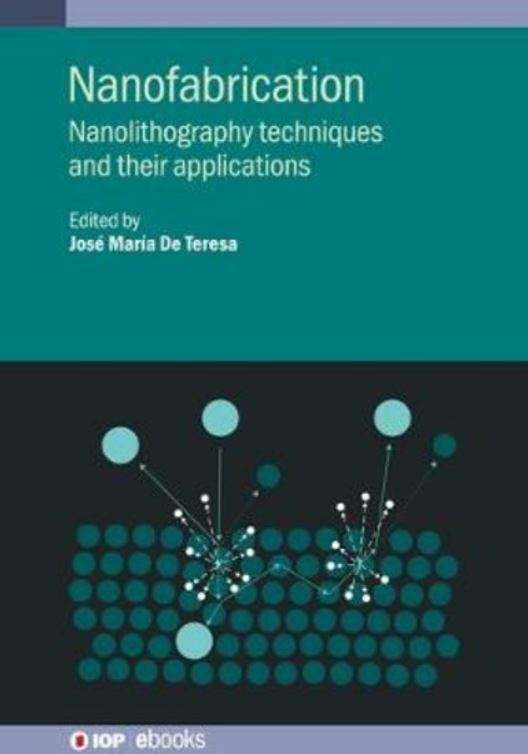
Magnetic nanopatterning via thermal scanning probe lithography
E. Albisetti, D. Petti, R. Bertacco, E. Riedo
Book chapter in “Nanofabrication”, Edited by José Maria De Teresa, IOP Publishing (2020).
A comprehensive edited volume on important and up-to-date nanolithography techniques and applications. The book includes an introduction on the importance of nanolithography in today’s research and technology, providing examples of its applications.
The remainder of the book is split into two sections. The first section contains the most important and established nanolithography techniques. As well as a detailed description of each technique, the reader can obtain useful information about the main advantages and drawbacks of each technique in terms of resolution, throughput, number of steps needed, cost, etc. At the end of this section, the reader will be able to decide which technique to use for different applications.
The second section explores more specific applications of the nanolithography techniques previously described; as well as new techniques and applications. In some cases, the processes described in these chapters involve a combination of several nanolithography techniques. This section is less general but provides the reader with real examples.

Patterned spin-textures for magnonics
E. Albisetti, D. Petti, R. Bertacco
Book chapter in “Three-Dimensional Magnonics”, Edited by Gianluca Gubbiotti, CRC Press (2019).
Magnonics, a research field that uses spin waves, collective excitations of ordered magnetic materials, or magnons (their quanta) as a tool for signal processing, communication, and computation, has rapidly grown during the past decade because of the low-energy consumption and potential compatibility with next-generation circuits beyond CMOS electronics. The interest in 3D magnonic nanostructures follows the latest trend in conventional electronics based on expansion from 2D planar to 3D vertically integrated structures. To remain on the same technological level, a similar expansion should be realized in magnonics.
Following this trend, this book provides an overview of recent developments in the exploitation of the third dimension in magnonics, with special focus on the propagation of spin waves in layered magnonic crystals, spin textures, curved surfaces, 3D nano-objects, and cavity magnonics. The book is unique in that it addresses, as an alternative to physical patterning, hybrid heterostructures in the form of bilayer systems (metal–insulator, metal-heavy metal, metal–antiferromagnet, and metal–ferroelectric), where new properties of spin waves emerge from interactions between the continuous magnetic film, where spin waves propagate, and the nonmagnetic component, which induces periodic modulation of either the static or the dynamic internal magnetic field of the magnetic film itself. The book comprises 11 chapters written by outstanding international research groups in the field of magnonics and will appeal to anyone involved in magnonics, spintronics, nanotechnology, microwave applications, and nanomagnetism.
Patents
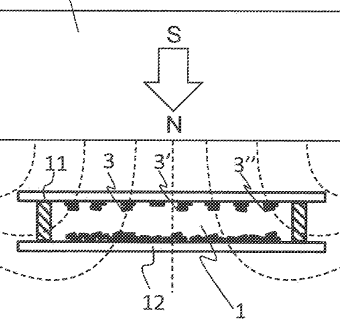
R. Bertacco, D. Petti, G. Ferrari, E. Albisetti, M. Giacometti, “Device and method for the quantification of cellular and non-cellular blood components”, US 2021/0086182 A1 (2021)
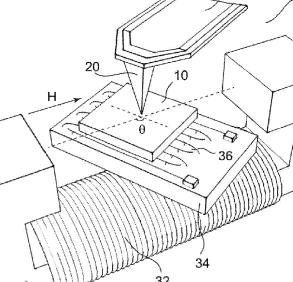
R. Bertacco, D. Petti, E. Albisetti, E. Riedo, “Method and equipment for magnetic nanopatterning of substrates”, US 2016/0172092 A1 (2016).




